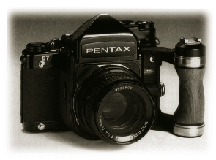
Oleg's Equipment and Techniques
My main camera is an EOS Elan (with second body coming -- hopefully--soon.)
Thus far I get by with two lenses, a basic 50/1,8 (cheap, light and good optically) and a 200/2,8 USM L (expensive, relatively heavy but fast in aperture and focusing.)
My only other accessory is 25mm extention tube. I yet have to replace the flash and most filters that was among my gear stolen in October '94. I did replace the orange filter -- my favorite for portraits(72mm - ouch!)
I have access to schools Norman 800 and 2000 strobes and a Pentax 67 with 135mm "macro"
(actually a joke, unless I add rented extention tubes.) Because the 135 is relatively prone to flare, lacks close focus and the P67 finder scratches my glasses I prefer my EOS. Also, with 35mm originals I can scan without making prints first. I use Photoshop for editing. Sometimes the changes are extensive, but mostly I just remove dust and scrateches.
Over the last three years I have used most 35mm bodies, mostly out of curiosity. However, when my camera were stolen, it was David Dyer-Bennet who let me use his OM-4 and FM-2 and thus enabled me to get through my classes.
I have also used Mamya C330, Yashica 124G, Rolleiflex, Fujica 645 and a variety of rail and press 4x5 cameras.
Usually, I ask people that I find interesting for some reason to model for me. 3 out of 4 indulge me. My portrait series is ever-growing, and I managed to find most subjects for the "Nudes: humans as still life" by simply looking around the computer labs at 2 a.m. My models get either prints or -- as in case when I shot B&W slides -- floppis with their photos digitized.)
Some thoughts on equipment:
- Try before buying. Fortunately for me, CPS is very good with providing lenses and bodies for just that (200/2,8 was picked after trying it and also 300/4 and 100/2, all courtesy of Canon)
- Get specialized equipments (i.e 28, 50, 105 and 200 instead of 28-200 zoom) -- as items dedicated for certain tasks tend to perform better, weight less and cost only a little more than something intended to be a compromise in all areas.
- Think before releasing the shutter. I have brought my ratio of taken:used to 1:20-30 now, from 1:100 last year.
- Use a tripod. Even a cheapo 75-300 zoom can make sharp photos if given adequate support. Lenses upwards of 300mm or just about anything in macro cannot even be pointed well without support.
- Use a lens shade -- especially if you like zoom lenses or filters.
Rec.photo has been a very valuable resource for me.
- Use a pro lab. The costs are usually modest and you'd be saved the
aggravation and expense of having your film ruined by incompetent
technicians. Locally, Ritz would be egregeous, while Prizm Studios among
the best. If you like to smell chemicals, you might even enjoy processing
your own film.
[ |
Main OTIS Page
|
Oleg's Main Page
| ]
Page last updated - 03-16-95 - Ed, ed@art.net

